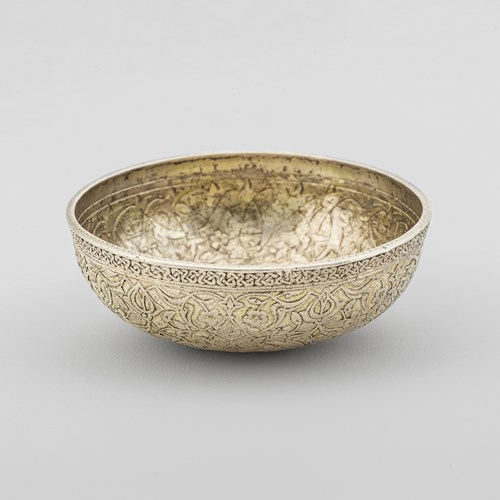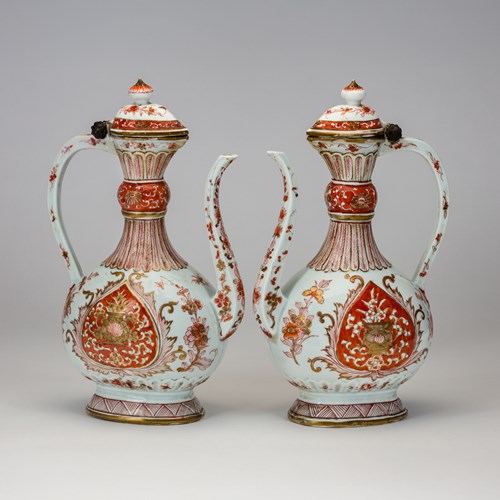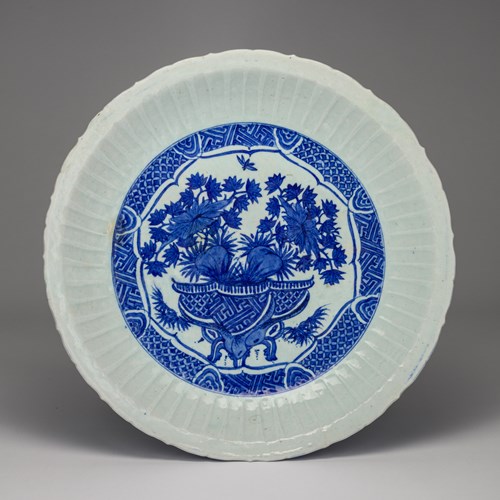Marketplace
A Large Blue and White Dish Made for the Thai Market
A Large Blue and White Dish Made for the Thai Market
Period Kangxi period
Origin China
Medium Ceramic decorated with underglaze polychrome
Dimension 47 cm (18¹/₂ inches)
A dark cobalt blue and white dish with a flared rim made in China for the Thai market. Whilst initially such pottery wares were assumed to be made for the Islamic market, studies since have indicated that they were made for the Thai market. The imagery on such wares was a good indication of the market it was intended for. These were ‘often decorated with a single flower in bloom as a central medallion,’ often a chrysanthemum, as is the seen on this dish.[1] The chrysanthemum ‘figures extensively in Chinese symbolism and represents autumn as it blooms at that time of year in the Chinese calendar.’[2] The chrysanthemum medallion sits within two richly decorated rings.
Motifs inspired by Buddhist and Hindu mythology are considered sacred such as lotus appear frequently on these. Here, the lotus-and-scrolling-stem motif is repeated throughout the dish as a filler design in the spaces between six stylised leaves and the rim of the dish. It is possible that stylised leaves radiating from the central medallion are peepal leaves, which are considered sacred to Buddhists (the Bodhi tree is a peepal tree) and Hindus alike. The stylised leaves provide symmetry to the patterns on the dish and themselves contain symmetrical floral and vine patterns within each leaf. The rim of the dish features more floral scrollwork.
On the base of the bowl, appears a stamp of the paired fish, from the Eight Buddhist Symbols. This is symbol of marriage, conjugal happiness fertility, and acted as a charm against evil.
This dish bears stickers indicating that it was exhibited at the International Tentoonstelling van Oude Kunst, Rijksmuseum, Amsterdam 1936, which was an international antiques trade fair. A pencil inscription reading ‘Hancock 95’ indicates that it was exhibited at this trade fair by H.R. Hancock, 37, Bury Street, St. James's London.
Comparative material:
A similar dish can be found in Chinese Ceramics in the Topkapi Saray Museum Istanbul, Vol III, (no. 2204) p. 914.
Bibliography
Habu, Anne, and Dawn F. Rooney, eds. Royal Porcelain from Siam: Unpacking the Ring Collection. Oslo: Hermes Publishing, 2013.
[1] Rooney, Dawn F. ‘Constructing an Identity for Bencharong and Lai Nam Thong’. In Royal Porcelain From Siam Unpacking the Ring Collection, edited by Anne Habu and Dawn F. Rooney. Oslo: Hermes Publishing, 2013, p. 36
[2] Ibid., p. 41
Stock no.: A5479
Motifs inspired by Buddhist and Hindu mythology are considered sacred such as lotus appear frequently on these. Here, the lotus-and-scrolling-stem motif is repeated throughout the dish as a filler design in the spaces between six stylised leaves and the rim of the dish. It is possible that stylised leaves radiating from the central medallion are peepal leaves, which are considered sacred to Buddhists (the Bodhi tree is a peepal tree) and Hindus alike. The stylised leaves provide symmetry to the patterns on the dish and themselves contain symmetrical floral and vine patterns within each leaf. The rim of the dish features more floral scrollwork.
On the base of the bowl, appears a stamp of the paired fish, from the Eight Buddhist Symbols. This is symbol of marriage, conjugal happiness fertility, and acted as a charm against evil.
This dish bears stickers indicating that it was exhibited at the International Tentoonstelling van Oude Kunst, Rijksmuseum, Amsterdam 1936, which was an international antiques trade fair. A pencil inscription reading ‘Hancock 95’ indicates that it was exhibited at this trade fair by H.R. Hancock, 37, Bury Street, St. James's London.
Comparative material:
A similar dish can be found in Chinese Ceramics in the Topkapi Saray Museum Istanbul, Vol III, (no. 2204) p. 914.
Bibliography
Habu, Anne, and Dawn F. Rooney, eds. Royal Porcelain from Siam: Unpacking the Ring Collection. Oslo: Hermes Publishing, 2013.
[1] Rooney, Dawn F. ‘Constructing an Identity for Bencharong and Lai Nam Thong’. In Royal Porcelain From Siam Unpacking the Ring Collection, edited by Anne Habu and Dawn F. Rooney. Oslo: Hermes Publishing, 2013, p. 36
[2] Ibid., p. 41
Stock no.: A5479
Period: Kangxi period
Origin: China
Medium: Ceramic decorated with underglaze polychrome
Dimension: 47 cm (18¹/₂ inches)
Provenance: Sir Thomas Fermor-Hesketh, 7th Bt. (1849-1924)
Sotheby’s, Easton Neaston, 11th May 2005, lot 789
Displayed at the International Tentoonstelling van oude kunst, Rijksmuseum, Amsterdam 1936, by H.R. Hancock, 37, Bury Street, ST James's London.
More artworks from the Gallery









